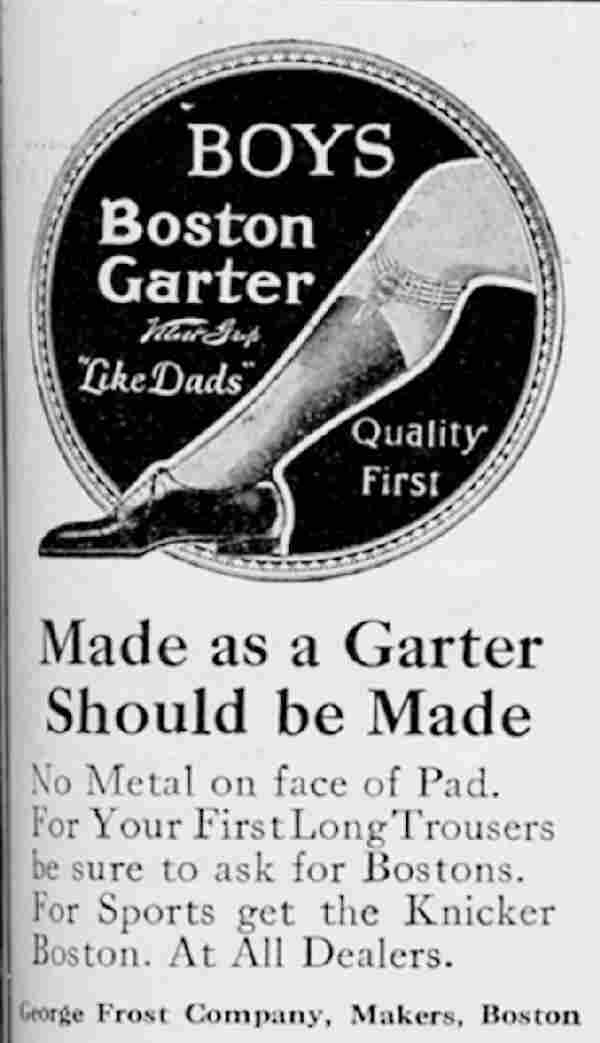
American Mail Order Catalogs with Boys Clothings: 1926--Boys' Boston Garters

Figure 1.-- The George Frost CompanyHere made garters for boys who had graduated to long trousers. We know very little about the George Frost Company which manufactured the Boston garter. They were located in Boston which perhaps ecplains why they were called the Boston garter.
|
|
The George Frost CompanyHere made garters for boys who had graduated to long trousers. We know very little about the George Frost Company which manufactured the Boston garter. They were located in Boston which perhaps ecplains why they were called the Boston garter. This ad appeared in The Youth's Companion for April 3, 1926, p. 559. This ad for boy's garters, appealing to boys who have just graduated to their first long trousers and want to wear the kind of garters their fathers wear to hold up calf-length socks. Before boys got their first long trousers, they wore garters of a different type--either (a) pin-on hose supporters for long stockings attached to underwaists or waist union suits or (b) round garters to be worn around the leg just below the knee to hold knee socks in place. Once they had abandoned knickers or short pants and had got their first "longies" (usually at about age 17 or 18), they could begin to wear garters like those of adult men.
We know very little about the George Frost Company which manufactured the Boston garter. They were located in Boston which perhaps ecplains why they were called the Boston garter. George A. Frost for whom the company was named was born in 1857 in Massachusetts to parents, George and Almira Frost, who came respectively from Connecticut and Maine. The family lived in Newton, Mass. by 1870. By 1880 the family lived 310 Highland Street, Newton, and George, the oldest son, was working for his father's business that specialized in "ladies furnishings." George's father was a dry goods merchant. Records indicate that the family business was called the George Frost and Company, founded by the elder George Frost, and taken over by his son, George the younger, at some point in the late 1880s. The firm was located on Devonshire Street in downtown Boston. It was damaged by fire in 1876. We note a new location at 551 Tremont Street. The company had two famous products. One was the "Boston Garter," a supporter for men and for older boys' calf-length socks.
This ad appeared in The Youth's Companion for April 3, 1926, p. 559. The Youth's Companion" described itself as "An Illustrated Weekly Paper For Young People and the Family." It was established in 1827. The magazine was published in Boston, Massachusetts, by the Perry Mason Company, 201 Columbus Avenue. It appeared under this title until 1929. It was in the late 19th century one of the most popular weekly periodicals in America and known for the quality of the writing. The magazinecatered to teen-age boys and girls especially, containing articles on sports, on hobbies, and on various literary and cultural interests. But it was really a family magazine and had many advertisements for clothing, both adult and
children's. The magagazine had a very strict policy about the advertising carried because its readers were mostly children.
Boys' Garters
This ad for boy's garters, appealing to boys who have just graduated to their first long trousers and want to wear the kind
of garters their fathers wear to hold up calf-length socks. Before boys got their first long trousers, they wore garters of a different type--either (a) pin-on hose supporters for long stockings attached to underwaists or waist union suits or (b) round garters to be worn around the leg just below the knee to hold knee socks in place. Once they had abandoned knickers or short pants and
had got their first "longies" (usually at about age 17 or 18), they could begin to wear garters like those of adult men. Interestingly, this ad points specificially to the transition from knickers to long trousers and advertises both the adult garters for older boys and the round knicker garters for the boys who weren't quite old enough to wear long pants yet. The round garters to be worn with knickers were also worn of course by older boys for sports purposes such as golf or football. And they could be worn with any knee socks
that had cuffs (such as those worn for soccer and, by younger boys, with short pants). Notice the mention of the "Velvet Grip" clasp--the same kind of button clasp used for children's hose supporters with the same brand name. The ad coopy read, "Boys Boston Garter. Velvet Grip. Like Dad's. Quality First.
Made as a Garter Should be Made. No metal on face of Pad. For your First Long Trousers be sure to ask for Bostons. For Sports get the Knicker Boston. At all Dealers. George Frost company, Makers, Boston."
HBC

Navigate the Boys' Historical Clothing catalog/magazine pages:
[Return to the Main American 1926 mail order]
[Return to the Main American 1920s mail order]
[Main photo/publishing page]
[Store catalogs]
[Fashion magazines]
Navigate the Boys' Historical Clothing Web Site:
[Return to the Main American Scout foiotwear page]
[Introduction]
[Activities]
[Biographies]
[Chronology]
[Cloth and textiles]
[Clothing styles]
[Countries]
[Topics]
[Bibliographies]
[Contributions]
[FAQs]
[Glossaries]
[Images]
[Links]
[Registration]
[Tools]
[Boys' Clothing Home]
Navigate the Boys' Historical Clothing Web Site:
[Sailor suits]
[Sailor hats]
[Buster Brown suits]
[Eton suits]
[Rompers]
[Knickers]
[Short pants]
[Smocks]
[Pinafores]
[Long stockings]
[Knee socks]
[Underwear]
Created: 8:25 PM 1/7/2005
Last updated: 8:27 PM 8/12/2010



